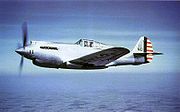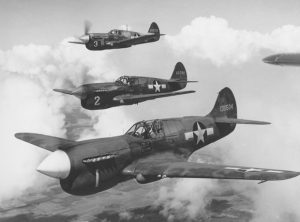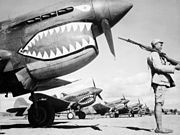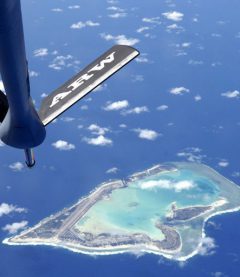 Introduction
Introduction
The Curtis P-40 Warhawk that was the mainstay of the United States Army Air Corp (USAAC) in pre-World War II days.
It is a single engine, single pilot, all metal fighter, ground attack aircraft and fighter-bomber.
It was primarily used by USAAC, RAF Royal Australian Air Force and Royal Canadian Air Force. The USSR used this type of aircraft as the “Tomahawk” which was an equivalent to the P-40.
The Curtis-Wright Corporation produced nearly 14,000 Warhawks of all models and uses, from 1939-1944. The last P-40 used by a military was retired by the Brazilian air Force in 1958.
Many aviation experts claimed the P-40 was obsolete by the time the United States entered WWII. This was because the P-40 lacked a two speed supercharger.
This did make the Warhawk inferior to German fighters at high altitude, but the P-40 was excellent at lower altitudes as a ground support and bomber aircraft.
Design and Development

On 14 October 1938, the XP-40 flew or the first time. It was base on a earlier built aircraft, the Curtis P-36.
The XP-40 used a Allison V-1710, V-12 inline engine which was liquid cooled, supercharged (but not two-speed).
The first test flight was clocked at 315mph which was not acceptable to USAAC. Further design and study by the Curtis engineers added about 60mph of speed to the Warhawk.
The aircraft was one of the fastest turning int the European Theater. In the Pacific, the Japanese “Zero” and the Japanese Army equivalent to the “Zero was the Ki-43 “Oscar”.
Both aircraft were a lot lighter then the Warhawk, thus able to out turn the P-40 at lower-medium speeds.
Claire Chenault his “Flying Tiger” pilots not dogfight the P-40 against Japanese fighters at low or medium speeds. However at faster speeds it was a different story, the P-40 was superior to any enemy aircraft.
In later models, the Warhawk was outfitted with the Merlin-Packard engine which produced 1,400hp.
However climb performance was rated fair to poor against most enemy fighter aircraft. But dive acceleration and dive speed was rated at good to excellent depending on the P-40s configuration.
The P-40 was considered inferior to the German Bf-190 at higher altitudes, but superior at lower altitudes .

Operation History
The Flying Tigers or American Volunteer Group (AVG) used the P-40Bs in combat in late 1941.
As a “contractor” for the Chinese, these plucky volunteers took on the Imperial Japanese Air Force and Imperial Japanese Navy (IJN) air corp.
The P-40 were very sturdy, faster in a dive and had an excellent roll rate.
The Warhawk was no match for the Japanese fighters: Nakajima Ki-27, Nakajima-43 and Mitsubishi Zero in slow speed maneuvers.
Claire Chennault, as I mentioned earlier, instructed his pilots to never get involved in a slow speed dog fights with the Japanese aircraft but to use the P-40’a strengths such as superior dive speeds and roll rates.
This strategy paid off as the Flying Tigers shot down 115 enemy aircraft and lost just 4 during a 6 1/2 month period.
This was very encouraging to the “folks back home” as things seemed pretty dark after Pearl Harbor.
However with the onset of the United States in the war now, the Flying Tiger squadron was absorbed into the United States Army Air Force (USAAF as it was now called).
North Africa
As mentioned earlier, the P-40 was inferior to the Bf-109. Werner Schroer destroyed 114 Allied aircraft, many of them P-40.
The leading German ace in North Africa, Hans-Joachin Marseille recorded 101 kills over the P-40.
Thus the P-40 played a diminished role in the European and North African Theaters.
Pacific
On 07 December 1941, the crippling sneak attack on Pearl Harbor occurred by the Japanese. Most of the P-40 Warhawks destroyed were on the ground parked side by side.
Just a few bombs destroyed a great number of P-40s at Wheeler USAAF Base in Hawaii. More were lost at Hickam USAAF also on Oahu.
Lt’s George Welch and Kenneth Taylor did manage to get airborne that fateful morning and shot down about half a dozen enemy aircraft.
There is a story floating around Hawaii that tells about a young boy of 10 or 11 out feeding the pigs on the family farm in Kona on the Big Island (Hawaii) in the late afternoon on 06 December 1941.
He saw an fighter flying low that came right over him. He noticed a bright red ball on the side of the fuselage and underside of the wing.
The aircraft was so close that he could see the pilot looking at him. He ran in the house and told his mother. She called the Sheriff’s department but they didn’t seem to have much interest. Nothing became of the report.
Had this young boy seen the first Japanese aircraft of the task force that would attack Pearl Harbor the next day? Was it the forerunner of doom for 07 December 1941?”

This was the image that was on USAAF aircraft the day the boy saw, in 1941. The red circle was removed from the insignia in early 1942 because even the experienced pilots might mistake that symbol for an enemy at various altitudes and speeds. So was this a friend or foe on 06 December 1941?
According to Gordon W. Prange, Naval Historian and author of “At Dawn We Slept”, the Japanese attack was an highly classified event.
Although there were about 1,000 individuals who were involved in the planning of the attack, security was very tight.
You have to remember back in those days, a breach of security usually spelled death to the “squealer”.
One of the key plans for success for the Japanese was to attack in total secrecy. It is highly doubtful that a “scout” plane from the carrier task force would be flying near the Hawaiian Islands the day before the attack.
This would have certainly tipped off the Americans of the upcoming event.
But as you look at the markings that were used at that time, the red ball in the middle of the star could be seen as an enemy aircraft.
You, the reader, can make your own decision.
Pearl Harbor
The attack on Pearl Harbor was a Tactical victory for Japan but a strategic blunder as the Pearl Harbor dry docks and fuel farms were untouched. 2 battleships-Arizona and Oklahoma were destroyed but the others-California, West Virginia, Nevada, Pennsylvania, Tennessee, Maryland and several heavy and light cruisers were all repaired and most saw action in the Pacific in later years.
Many of the USAAF aircraft were heavily damaged or destroyed. Out of about 359 aircraft on Oahu that fateful day, 188 were lost most of them P-40s.
But none of the Naval fighters or any USN aircraft were damaged because the two aircraft carriers-Enterprise and Lexington were delivering F-4Fs to Midway and Wake Island .
They were a couple thousand miles from Pearl Harbor when it was attacked.
So it wasn’t the attack on Pearl Harbor that the Japanese had hoped for. The main objective was to eliminate the U.S. Pacific Fleet from engaging IJN at a later date.
What it did do was bring the United States into the World War II and sealed Japan’s fate.

As the war progressed in the early stages after Pearl Harbor, the Philippines was under severe attack and like Pear Harbor, many P-40s were caught on the ground and destroyed.
Although many squadrons did well against Japanese aircraft, they would be sorely outnumbered both in the air and on the land. Also a lack of spare parts were becoming a major problem.
Many of the squadrons, with operational aircraft, were relocated to the Dutch West Indies (Java). They served with honor and distinction. The same was true of the flight groups that were assigned to the Solomons.
The war in the Pacific was now expanding to more and more islands and locations further from each other. The P-40 was not a long ranged aircraft. Soon they were replaced by the longer ranged P-38 Lightning and eventually the P-51 Mustangs.
Many pilots who initially flew the P-40 Warhawk and then transitioned to the P-38 or P-51, said the P-40 was equal to the newer aircraft in a combat sense.
As the war progressed into the latter years, the P-40 was relegated to Recon, CAP (Combat Air Patrol), and escort duty with small groups of bombers (B-25, B-26). The Warhawk served with great distinction, especially in the early years in the war in the Pacific.
Curtiss Aircraft Company and affiliates produced nearly 14,000 Warhawks. Today only 28 reaming P-40s are airworthy. There are 13 aircraft on static display at Air Museums around the world with 36 airframes under restoration .
Check with your local air museum in your area to visit the fine, venerable Warrior.
Tech Specs for the P-40 Warhawk
Wing Span: 37 ft 3 in
Length: 31 ft 7 in
Height: 12 ft 3 in
Weight: 8,280 lbs (MTOW)
Max Speed: 360 mph; Cruise: 270
Ceiling: 29,000 ft
Range: 650 sm
Engine: 1/Allison V-1710-39 liquid cooled V-12 engine rated at 115o hp
Crew: 1
THANKS FOR READING! I HOPE THIS WAS INFORMATIVE!
Save
Save
Save
Save
Save
Save
Save
Save
Save
Save
Save
Save
Save
Save
Save
Save
Save
Save
Save
Save
Save
Save
Save
Save
Save
Save
Save
Save
Save
Save
Save
Save
Save
Save
Save
Save
Save

